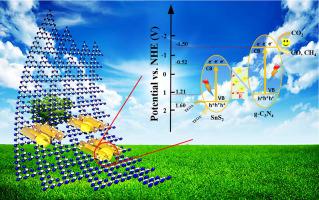Chemical Engineering Journal ( IF 15.1 ) Pub Date : 2020-08-28 , DOI: 10.1016/j.cej.2020.126776 Shikang Yin , Linlin Sun , Yaju Zhou , Xin Li , Jinze Li , Xianghai Song , Pengwei Huo , Huiqin Wang , Yongsheng Yan

|
The use of semiconductor photocatalytic reduction technology has higher efficiency and lower energy consumption for CO2 reduction, but its existence of some mismatched energy band positions and relatively slow charge-hole separation greatly limits its practical application. In this paper, a SnS2/Au/g-C3N4 embedded structure model with carbon and nitrogen hybridization is proposed to gain an in-depth understanding of the role of hybridization and precious metal modification in photocatalysis. Carriers were investigated from the perspective of kinetics through photocurrent, LSV curve, and FL spectroscopy. After modification of Au nanoparticles, the photo-excited electrons showed a slower decay process, indicating that the separation of carriers was enhanced, which was further confirmed by impedance and PL spectroscopy. SEM, AFM and TEM analysis confirmed that the 2D face-to-face SnS2/Au/g-C3N4 embedded structure was successfully prepared and the Au nanoparticles were evenly distributed. Au nanoparticles not only act as a bridge for electron transport in 2D semiconductor materials to accelerate electron transport, but generate more excited electrons by themselves under the radiation of sunlight, which effectively improves the separation efficiency of electron-hole pairs and enhances the photocatalyst activity. DFT calculations show that the Z-type mechanism and the intercalated energy level of the SnS2/Au/g-C3N4 embedded structure expand the light absorption and improve the carrier separation efficiency. As expected, the photocatalyst activity with CO and CH4 the evolution rate of up 93.81 µmol·g−1·h−1 and 74.98 µmol·g−1·h−1 under visible light irradiation, respectively, while the photocatalytic activity is negligible loss after 30 h photoreduction. This work reveals the role of embedded structure and precious metal modification in the separation and transmission of electron-hole, opening up new perspective for achieving high-efficiency solar CO2 reduction performance.
中文翻译:

SnS 2 / Au / gC 3 N 4嵌入结构中增强的电子-空穴分离,可有效还原CO 2
半导体光催化还原技术的使用具有较高的效率和较低的CO 2还原能耗,但是其存在一些不匹配的能带位置和相对较慢的电荷-空穴分离极大地限制了其实际应用。本文中的SnS 2 / Au / gC 3 N 4提出了一种具有碳氮杂化的嵌入式结构模型,以深入了解杂化和贵金属修饰在光催化中的作用。通过光电流,LSV曲线和FL光谱从动力学角度研究了载体。Au纳米粒子改性后,光激发的电子显示出较慢的衰减过程,表明载流子的分离得到增强,这通过阻抗和PL光谱进一步证实。SEM,AFM和TEM分析证实2D面对面SnS 2 / Au / gC 3 N 4成功制备了包埋结构,金纳米颗粒均匀分布。金纳米颗粒不仅充当2D半导体材料中电子传输的桥梁以加速电子传输,而且在阳光的照射下自身产生更多的激发电子,从而有效地提高了电子-空穴对的分离效率并增强了光催化剂的活性。DFT计算表明,Z型机理和SnS 2 / Au / gC 3 N 4嵌入结构的嵌入能级扩展了光吸收并提高了载流子分离效率。不出所料,CO和CH 4对光催化活性的释放速率高达93.81 µmol·g -1·h -1和74.98μmol·g -1 ·h -1分别在可见光照射下,而光催化活性在30 h光还原后的损失可忽略不计。这项工作揭示了嵌入结构和贵金属修饰在电子-空穴的分离和传输中的作用,为实现高效的太阳能CO 2还原性能开辟了新的前景。


























 京公网安备 11010802027423号
京公网安备 11010802027423号